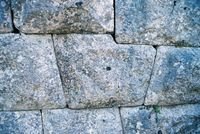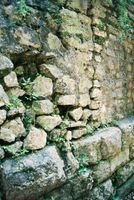As a whole the site itself is oddly unimpressive. Most of Butrint is still covered, so the site comprises a number of isolated ruins separated by woodland. This makes it hard to get a sense of the scale of the place unlike, say, Pompeii or Herculaneum. Still it is worth visting as some of the individual pieces of the site are very interesting indeed.

The original walls of Butrint

This is part of the city walls built in the 4th century BC by fleeing Trojans (the gateways are far too small and narrow to allow the ingress of a giant wooden horse...) It is difficult to get a sense of scale from this photograph, but the wall is built of blocks of stone about 60cm wide. Each block is irregularly shaped to fit together sturdily.

Roman refactoring

Now this is how some later conquerors - the Romans - rebuilt the broken city walls in the 2nd century AD. Initially they attempted to reassemble the walls using the original stone blocks but it was too difficult to fit the pieces together. However, the Romans had a technology that the earlier builds lacked: mortar. So they broke the blocks into smaller, more regularly shaped pieces and built the walls anew. The walls are still resisting the overturning moment almost two millenia later.
In other words, it is easier to build lasting structures out of small reusable components than out of large specialised chunks.
1 comment:
I was lucky enough to spend a long day exploring Butrint back in 1994 when I was working in Albania for a couple of months. I found it quite impressive to tell the truth, though I understand that it may not be so impressive if compared for example to the glamour of some of the more complete ruins like the Forum in Rome.
If you ever get the chance to go back to the southern part of Albania I'd recommend a visit to Gjirokastra - it's a couple of hours drive from Sarander - a fascinating city that had been restored and preserved (at least it was then) as a museum by the Hoxha regime.
Living in a rented fourth floor flat a mile or so from the centre of Tirana for a couple of months was a very interesting time. I'll go back one day to see how it's changed.
Post a Comment